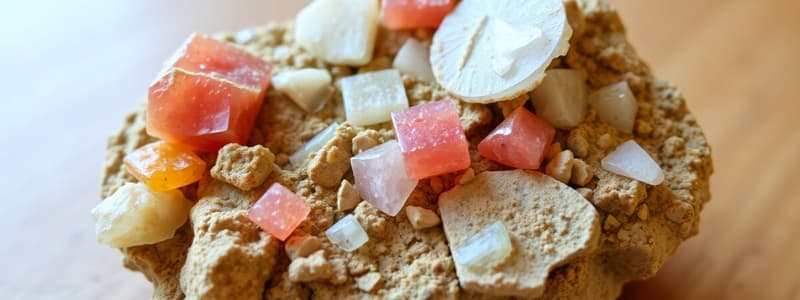Podcast
Questions and Answers
Which property of a mineral is considered the least reliable for identification?
Which property of a mineral is considered the least reliable for identification?
- Cleavage
- Color (correct)
- Hardness
- Transparency
Which of the following minerals can be scratched by a copper penny?
Which of the following minerals can be scratched by a copper penny?
- Talc
- Halite
- Quartz
- Gypsum (correct)
What characteristic describes how a mineral's surface reflects light?
What characteristic describes how a mineral's surface reflects light?
- Fracture
- Transparency
- Luster (correct)
- Odor
Which mineral is known for its flexible tenacity and can be bent without breaking?
Which mineral is known for its flexible tenacity and can be bent without breaking?
Which mineral form is indicated by a conchoidal fracture?
Which mineral form is indicated by a conchoidal fracture?
What is the composition of igneous rocks?
What is the composition of igneous rocks?
What tool is best for measuring the density of a small piece of silver ore?
What tool is best for measuring the density of a small piece of silver ore?
What type of rock is formed from the remains of once-living organisms?
What type of rock is formed from the remains of once-living organisms?
What is the process by which rocks break down through chemical reactions called?
What is the process by which rocks break down through chemical reactions called?
Which type of volcano is characterized by a broad base and low dome shape?
Which type of volcano is characterized by a broad base and low dome shape?
What defines endogenic processes in the Earth's geological context?
What defines endogenic processes in the Earth's geological context?
What term describes the slow downslope movement of soil and rock debris saturated with water?
What term describes the slow downslope movement of soil and rock debris saturated with water?
Which scale measures the magnitude of an earthquake?
Which scale measures the magnitude of an earthquake?
What process involves the removal of surface material through natural forces like wind or water?
What process involves the removal of surface material through natural forces like wind or water?
What is a significant factor contributing to the process known as slump?
What is a significant factor contributing to the process known as slump?
Which phenomenon results from the absence of vegetation combined with heavy rainfall causing soil saturation?
Which phenomenon results from the absence of vegetation combined with heavy rainfall causing soil saturation?
Flashcards
Mineral
Mineral
A naturally occurring, homogenous solid with a specific chemical composition, ordered atomic structure, and characteristic physical properties.
Mineral Hardness
Mineral Hardness
A mineral's resistance to being scratched, measured using the Mohs Hardness scale.
Mohs Hardness Scale
Mohs Hardness Scale
A scale that ranks minerals from softest (talc) to hardest (diamond), based on their scratch resistance.
Igneous Rock
Igneous Rock
Signup and view all the flashcards
Sedimentary Rock
Sedimentary Rock
Signup and view all the flashcards
Crystal Structure
Crystal Structure
Signup and view all the flashcards
Streak
Streak
Signup and view all the flashcards
Specific Gravity
Specific Gravity
Signup and view all the flashcards
Metamorphic Rock
Metamorphic Rock
Signup and view all the flashcards
Metamorphism
Metamorphism
Signup and view all the flashcards
Endogenic Processes
Endogenic Processes
Signup and view all the flashcards
Exogenic Processes
Exogenic Processes
Signup and view all the flashcards
Earthquake
Earthquake
Signup and view all the flashcards
Seismogram
Seismogram
Signup and view all the flashcards
Physical Weathering
Physical Weathering
Signup and view all the flashcards
Chemical Weathering
Chemical Weathering
Signup and view all the flashcards
Study Notes
Rocks and Minerals
- Minerals are naturally occurring, homogeneous solids with specific chemical compositions and highly ordered atomic structures. They have specific physical properties.
- Crystals are solids with three-dimensional plane faces.
- Mineral properties for identification:
- Color: Least reliable, some minerals have similar colors.
- Streak: Color of a mineral in powdered form (more reliable). Halite and quartz are minerals that are difficult to distinguish by color alone
- Hardness: Resistance to scratching (Mohs Hardness Scale).
- Mohs Hardness Scale lists minerals from hardest to softest. Diamond is the hardest, and talc is the softest.
- Cleavage/Fracture: How a mineral breaks.
- Cleavage: Breaks along smooth, flat surfaces (mica).
- Fracture: Breaks along irregular surfaces (quartz).
- Quartz is a transparent gemstone with conchoidal fracture and is relatively brittle.
Properties of Minerals
- Gypsum can be scratched by a copper penny.
- Talc is the softest mineral and can be scratched by a fingernail.
- Luster describes how a mineral reflects light.
- Specific gravity (density) is the weight of a mineral compared to the weight of water.
Rocks
- Rocks are aggregates of minerals or rock fragments.
- Types of rocks:
- Igneous: Formed from cooled magma or lava.
- Lava is magma that reaches the Earth's surface.
- Sedimentary: Formed from the remains of once-living organisms (fossils) or compacted sediment.
- Metamorphic: Formed by heat and pressure changing existing rocks.
- Igneous: Formed from cooled magma or lava.
Rock Cycle
- The rock cycle describes the continuous processes that transform rocks from one type to another.
Endogenic and Exogenic Processes
- Endogenic processes occur below the Earth's surface and are driven by heat and gravity.
- Exogenic processes occur at or near the Earth's surface and are driven by forces like water, wind, and ice. Examples include faulting, solidification, weathering, mudflows, mass wasting, and erosion.
Studying That Suits You
Use AI to generate personalized quizzes and flashcards to suit your learning preferences.




